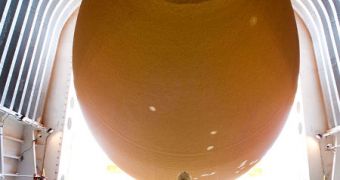Experts at the NASA Michoud Assembly Facility, in New Orleans, announce that they have just finished working on the last planned external fuel tank, and that the assembly will be shipped to the KSC.
The external fuel tank (EFT) is an indispensable accessory to the space shuttle. It is the component which people most often mistake for a rocket, though there's no fire coming out of it.
When in full launch configuration, a NASA orbiter is attached to the EFT, which in turn is attached to two solid rocket boosters (SRB), which are the stick-like structures on the side of the fuel tank.
After separation, the SRB detach first, followed by the EFT. The shuttle then needs to rely on its own engines and maneuver thrusters to get to the International Space Station (ISS).
Before launch, the SRB are mated with the tank inside the cavernous Vehicle Assembly Building (VAB), at the NASA Kennedy Space Center (KSC), in Cape Canaveral, Florida.
The shuttles are then taken out of the Orbiter Processing Facility (OPF), and carried into the VAB, where they are mated with the already-vertical EFT-SRB assembly.
This is precisely what will happen to the new tank, called ET-122, which is to fly to space with the orbiter Endeavor, in the last planned shuttle mission.
The flight will take place in February 2011, and the spacecraft will take off from the Launch Pad 39A facility at the KSC. This is the only pad left that can handle shuttle launches.
The ET-122 was delivered out of Michoud on Tuesday, September 21, after it was reconditioned. The tank suffered damage during 2005's Hurricane Katrina, and needed extensive repairs.
It was rolled out to an enclosed barge, and then began a 900-mile (1,450-kilometer) journey to Florida. The journey will take place exclusively by sea, and will last for five to six days.
This particular shipment is expected to arrive at the KSC on Sunday, September 26. The restoration plans was devised and executed by engineering teams at Denver, Colorado-based Lockheed Martin Space Systems Co.
The company has been the primary contractor for building the Space Shuttle Program's external fuel tanks for about 29 years. Engineers with the company have thus far built 135 EFT for shuttle missions.
“During a shuttle launch, the external tank delivers 535,000 gallons of liquid hydrogen and liquid oxygen propellants to the shuttle's three main engines,” Lockheed Martin says in a press release.
“Despite the tank's size, the aluminum skin covering it is only one-eighth-inch thick in most areas. Yet, it withstands more than 6.5 million pounds of thrust during liftoff and ascent. The tank is the only shuttle component that is not reused,” the document concludes.

 14 DAY TRIAL //
14 DAY TRIAL //